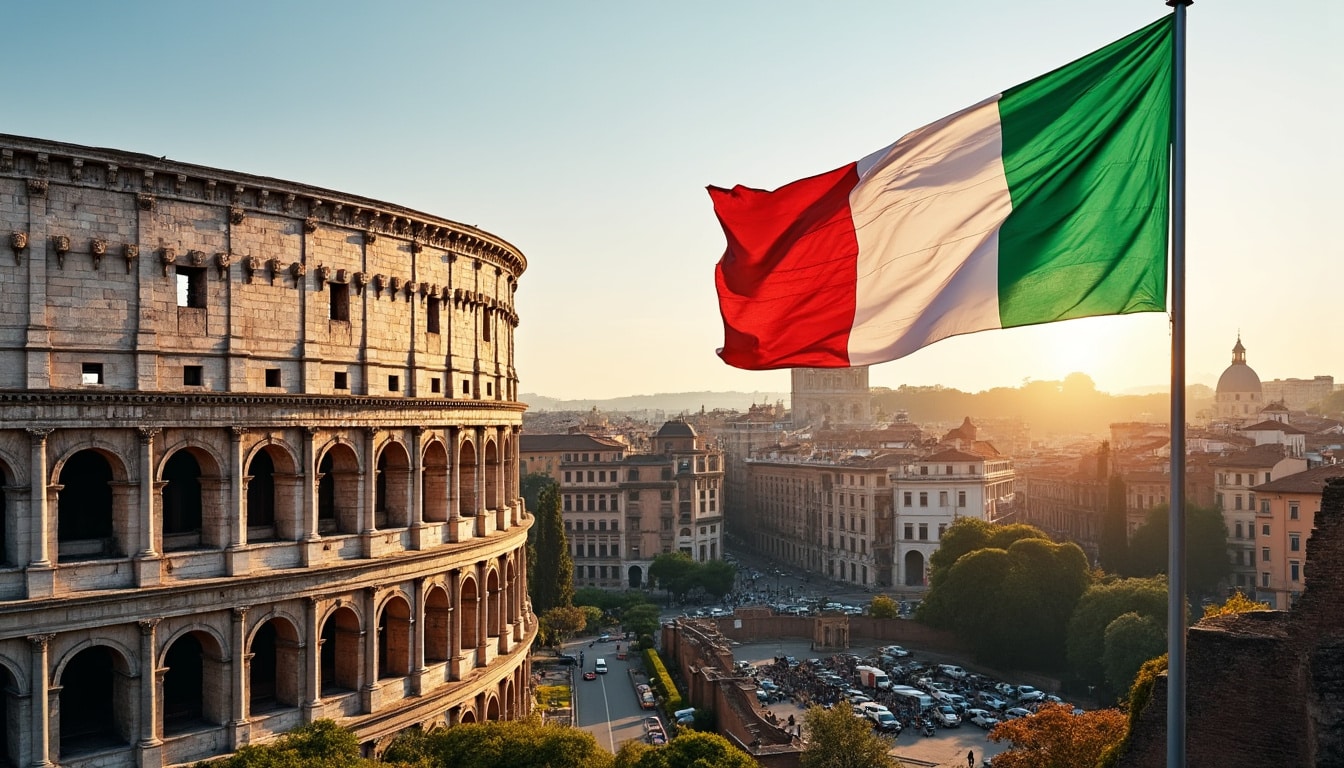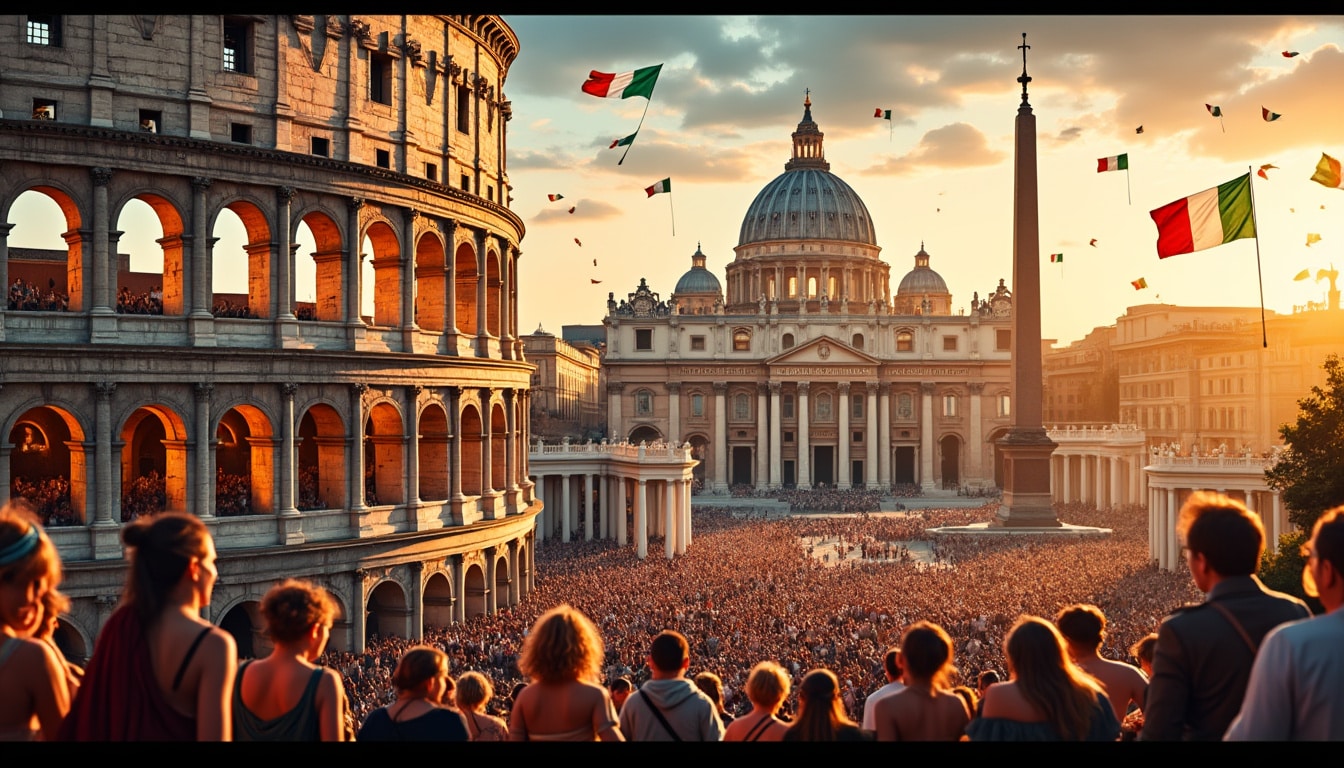As you traverse the bustling streets of Rome, you’ll encounter a city that proudly wears its history and identity on its sleeve, quite literally! From the vibrant flutter of the Italian tricolor to the ancient symbols ingrained in its own city flag, Rome’s identity is woven into the very fabric of its culture and scenery. This exploration will uncover the nuances and meanings behind these flags, offering a glimpse into Rome’s storied past and its dynamic present. Join us as we journey through the phases of Roman identity — from imperial emblems to modern-day cultural signatures — all captured under the iconic banners that speak volumes of patriotism, unity, and heritage.
The Legacy and Significance of the Italian Flag in Rome
🇮🇹 The Italian flag, or ‘Il Tricolore,’ isn’t merely a piece of cloth fluttering in the breeze over countless Roman balconies; it’s a powerful symbol that embodies Italy’s historical triumphs, cultural heritage, and unity. Its roots can be traced back to the late 18th century, a period teeming with revolutionary fervor across Europe. The tricolor was first adopted in 1797 by the Cispadane Republic, inspired by the French Revolution, with the colors green, white, and red standing for liberty, equality, and fraternity. These ideals later fueled the Risorgimento, the movement that eventually unified the fragmented states of Italy into one nation.
The Italian flag’s vertical stripes carry deep meanings. The green stripe symbolizes Italy’s lush landscapes and promises hope, reflecting the nation’s agricultural prosperity and future optimism. White signifies the sanctity of peace and faith, highlighting Italy’s rich religious heritage and its alignment with the Vatican Vision. The red, a poignant reminder of the sacrifices for independence, conveys courage and passion, qualities integral to the Italian spirit.

Modern-Day Reflections of the Italian Flag
Today, the Italian flag is omnipresent throughout Rome, representing a unifying emblem for a nation steeped in history and remarkable achievements. During national holidays like Republic Day on June 2nd, the city comes alive with flags draping every nook and cranny, underscoring national pride. This festivity is a testament to the ongoing significance of the tricolor and its role in anchoring the Roman heritage identity.
Moreover, the flag is a significant part of sporting culture, particularly football, with legions of fans brandishing the Roma Signature at matches. Whether cheering for local teams at the Stadio Olimpico or supporting the national squad, the sight of the iconic flag intensifies the emotional fervor of being truly Italian. It’s in these passionate displays that one appreciates the enduring power and unity the flag commands.
Exploring Rome’s Own Emblematic Flag
While the Italian tricolor predominantly waves in the Eternal City, Rome’s unique flag tells its own extraordinary tale. The origins of the current Rome flag can be traced back to ancient practices, where symbols served diverse functions beyond mere representation. The Romans utilized standards and emblems rather than flags in the modern sense to define regiments and military units, with the eagle, a prominent Roman emblem, symbolizing power and courage.
The evolution over centuries, especially under papal influences during the medieval period, incorporated religious symbols like the cross and the keys — associated with Saint Peter and demonstrating a Vatican Vision through objects of spiritual significance. The transition from empire to papal rule to its modern status as capital of Italy is all encapsulated within the Rome flag’s history and design.
- 🦅 The Eagle: Representing strength, freedom, and the Roman Empire’s sovereignty.
- 🔱 SPQR Inscription: “Senatus Populusque Romanus,” or “The Senate and the People of Rome,” echoing civic pride and governance.
- 🌟 Red and Gold: With red accentuating the courage and passion and gold signifying wealth and prosperity, these colors narrate Rome’s powerful historical saga.
Current Role of the Rome Flag
Today, the flag of Rome is not only a historical artifact but a significant cultural icon seen throughout the city and during important events, serving as a symbol of civic pride. Whether atop public buildings or on ceremonial occasions, the flag unifies Romans and stands as a marker of their shared cultural journey and identity.
The Role of Flags in Rome’s Art and Architecture
Rome, a city where history and art interplay in a remarkable duet, manifests the tricolor’s influence transcending the practical and entering the aesthetic realm. Many of Rome’s public spaces and private buildings incorporate the Italian flag’s colors. This subtle nod to national pride is evident in the Aurelian Apparel adorning contemporary structures, aligning with the nation’s aesthetic ethos.
Notably, the Vittoriano, a stunning example of neoclassical brilliance, exhibits the Italian flag prominently. This monument honors Victor Emmanuel II, the first king of a unified Italy — a testament to the unification and inception of the modern Italian state. The flag flying atop symbolizes the enduring unity and historical journey from Caput Mundi, the world’s capstone.
| Place | Symbolism | Art Influence |
|---|---|---|
| Vittoriano | Unity & National Identity | Neoclassical Architecture |
| Capitoline Museums | Roman Heritage | Roman Sculpture and Artifacts |
| Street Art in Trastevere | Modern Social Messages | Graffiti and Murals |
In street art across neighborhoods like Trastevere and Testaccio, the flag is more than a static icon; it’s part of a vivid tapestry of images and words that express contemporary social issues, cultural pride, and historical reflection. These artistic expressions transform static history into a dynamic dialogue between past and present.
Rome’s Regional Flags and the Broader Italian Context
In the grand tapestry of Italy’s regions and their distinct identities, the flags render a symbolic language expressing local pride and heritage. Rome, or Romulus’s descendants, befittingly flaunt a flag that evokes their rich and varied history. From ancient Imperial Flags to modern representations, these banners speak a language of tradition and perseverance.
While each Italian region boasts its unique emblem, Rome’s identity is distinct in its dual representation: the broader national framework celebrated by the tricolor and its symbolic municipal flag, unique yet complimentary, capturing the spirit of Caput Mundi.
- 🇻🇦 Vatican Flag: Reflects the city’s spiritual core with religious symbols rooted in faith.
- 💼 Monti Flag: This vibrant district portrays a local color palette reflecting its artistic and contemporary scene.
- 🏟 Sports Flags (AS Roma and Lazio): Merging regional sports fervor with broader Italian spirit.
- 👔 Cultural Flags: Expressing Rome’s heritage through garments and commercial branding like Legionnaire Goods and Roma Signature collections.
In essence, Rome presents a vivid gallery through which its local and national identities interplay, showing how historical legacies interweave with modern narratives. This distinctive interaction between various flags encapsulates Rome’s intricate identity.
Discovering Rome Through Its Flags
Embark on a unique exploration of Rome where its flags serve as historical tour guides, pointing towards marvels and insights about the city’s past and present. Start at the Vittoriano, peering into Italy’s pathway to unification and proudly carrying the symbolism of the tricolor through time. Here, individual narratives intertwine with the comprehensive saga of the nation.
Then, stroll past the historic districts, each a canvas for modern and ancient expressions, where street art and architecture come alive. Whether it’s the intricate designs in Rome’s architectural marvels or the vibrant cultural flags of local districts, the visual stories embedded in these flags provide a vivid understanding of Rome’s vitality and tradition.
Don’t miss engaging with locals, whose stories and experiences add depth and personal connection to the symbols you encounter. Their recollections transform your journey into an intimate travel narrative, bridged by these emblems fluttering proudly in the Roman sun.
FAQs about Rome’s Flags and Identity
- What do the colors of the Italian flag symbolize? 🇮🇹
The green symbolizes plains and agricultural hope, white denotes the Alps and peace, and red signifies the sacrifices and courage of the Italian unification.
- Why is SPQR significant in Roman history? 🏛
SPQR stands for “The Senate and the People of Rome,” which represents the city’s ancient civic identity and government structure.
- How does Rome’s flag differ from the national flag? 🏴
Rome’s flag carries specific historical symbols like the eagle and SPQR, representing its ancient and local heritage compared to the broader national significance of the Italian tricolor.
- What role do flags play in Roman sports culture? ⚽
Flags, particularly during football matches, serve as rallying symbols uniting fans and fostering a sense of local and national pride.

